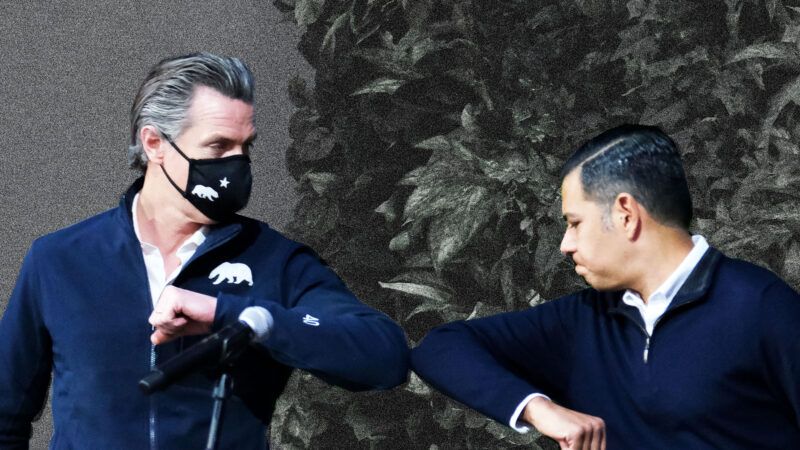COVID Revealed America To Be Nation of Rulers, Not of Laws
COVID Revealed America To Be a Nation of Rulers, Not of Laws
Life is returning to "normal" after two years, but that normal includes even fewer limits on executive powers.

(Dean Musgrove/ZUMAPRESS/Newscom)
"The United States is a nation of laws, badly written and randomly enforced," noted the late musician and satirist Frank Zappa. I often think of that snarky comment as I write about the sausage-making process in city councils, state legislatures, and the federal government. Did I mention that California's state government has 518 agencies, boards, and commissions?
Our system of checks, balances, more checks, additional balances, impact reports, legal challenges, voter initiatives, regulatory rulemakings, and administrative hearings frustrates people who want to "get something done." Americans spent $14 billion on the 2020 election cycle to influence political outcomes—and that was just for the presidential and congressional races.
I once ran a modest state bill to reduce the insanely onerous licensing regulations for people who shampoo hair at salons. After months of hearings and debate, the Assembly defeated it for going too far. That explains the public's desire to cut through the red tape and, as Arnold Schwarzenegger once promised, "blow up the boxes" of government.
Yet after COVID-19, it's obvious our democratic system of lawmaking is, as Winston Churchill put it, "the worst form of government, except for all the others." Given the choice between a system resembling a Rube Goldberg cartoon (with his bizarre and overly complex contraptions designed to complete simple tasks) and one that's streamlined and efficient, I'll take Goldberg's vision any day.
As we saw throughout the country but in California in particular, governors were happy to dispense with the usual checks and balances and impose rules by executive order and fiat. Some initial rules were defensible during a public-health crisis, but it wasn't long before elected officials operated like czars—imposing illogical and contradictory restrictions that made no rhyme or reason.
They kept moving the goalposts. One day, counties were on lockdown based on such and such infection rates, but the next day standards changed. In September 2020, for instance, Gov. Gavin Newsom issued a re-opening blueprint based on COVID cases per 100,000 population, but then he refused to let counties that met the standard to loosen up their rules.
"A week after announcing the new blueprint, Newsom announced that the state would actually adjust those raw numbers using an algorithm based on testing rates," according to an NPR report. "Each county's case rate gets bumped up or down depending on how their testing rates compare to other counties." Californians got the sneaking suspicion we simply were subject to the whims of the king.
I viewed the pandemic as serious, but it became obvious that many rules the governor imposed had nothing to do with containing the virus. Governors (and not just Newsom) and federal regulators followed the Rahm Emanuel school of thought ("Never allow a good crisis to go to waste")—and used the pandemic to impose policies they always supported but could never pass via the usual channels.
"Newsom has used his executive authority to shut down businesses, move local elections to vote-by-mail, accelerate spending on homeless shelters, alter court proceedings and provide benefits for essential workers," according to an April 2020 Politico report appropriately headlined, "Newsom executive orders test constitutional bounds—and legislative goodwill."
The previous month, Assemblyman Kevin Kiley (R–Rocklin) published a 138-page document detailing the 400 laws the governor had unilaterally changed following his State of Emergency declaration. "Our founders had good reasons for rejecting autocratic models of government in favor of separation of powers, checks and balances, and the rule of law—all of which Gavin Newsom has discarded," Kiley wrote.
Kiley and Assemblyman James Gallagher, R-Yuba City, challenged this in court, arguing the 1970 California Emergency Services Act does not give the governor authority to "legislate by unilaterally amending existing statutory law." The specific issue centered on the governor's decision to send vote-by-mail ballots to all of the state's voters—a good idea, in my view, but one that should have taken place by normal legislative action.
The Sutter County court sided with the Assembly members, although the decision didn't affect the election because the Legislature approved vote-by-mail after Newsom's order. That in itself proved that such executive actions often were inappropriate. There was plenty of time to pass the measure correctly, but Newsom preferred to impose the measure with a stroke of his pen.
An appeals court sided with the governor and found the emergency act gave him vast authority—including the "police power" to create new law. The California Supreme Court let the appeals court decision stand, meaning that in any declared emergency the governor can do whatever he deems appropriate without serious checks or balances.
Last month, Newsom mercifully lifted the vast majority of edicts and orders—but the precedent has been set for future emergencies. There are no real limits on executive power. Life is returning to normal after two long years, but I might never again complain about our convoluted democratic process.




Post a Comment